Thursday, April 21, 2022
Congratulations on your purchase of a fine alpaca product!
You may find that with proper care, your valuable alpaca garment will become a personal favorite or even a family heirloom! Properly cared for, your well made alpaca garment should last a very long time. Here are some tips, gleaned from experts, on the best ways to keep your fine alpaca garment clean and in good shape for years to come…
We do not recommend using a washing machine to clean natural animal fiber garments. We recommen read more...
|
Friday, April 8, 2022
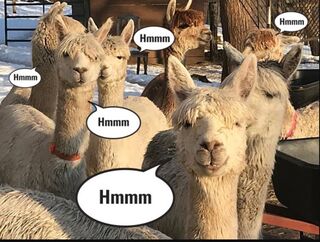
We Hmmm when we are happy!
Let’s review the various types of alpaca sounds:
Humming – This is the primary method of communication and it starts at birth. When a new cria (alpaca baby) is born, the mother and cria hum constantly to each other. It is their way to communicate and stay connected. Alpacas will also hum in an effort to express distress or anger. This is especially true if living arrangements are changed, they are moved, or they are separated from their herd. Alpacas may also hum if they are curious, happy, o read more...
|
Monday, April 4, 2022
Test run and the end results.
Washed:
5 towels 3 hand towels and 3 wash cloths - exact same towels in each load.
Both loads were washed on hot with the spin cycle between medium and extra high
Both loads were dried with dry flow sense - very dry setting on medium temperature
Before each load was dried a different load in the dryer and cleaned the dryer lint trap. So the temperature would be the same starting temp.
The same amount of laundry detergent in both loads and did not read more...
|
Saturday, April 2, 2022

Here We Go Again!
Agist- When an alpaca owner lets his/her animal live at someone else’s farm, this is called “boarding” or “agisting.”
Alpaca Talk :
Bugling – The warning sound made by alpacas when they trouble or a threat.
Clucking – The sound alpaca moms make when they talk to their baby (cria).
Humming – The sound alpacas make when they are talking to one another.
Carding – The process of combing and cleaning alpaca fiber.
Cria – A baby alpaca (ei read more...
|
Wednesday, March 30, 2022
What is an alpaca?
Alpacas are members of the camelid family. Most people are familiar with the ones with humps; the dromedary of Northern Africa, the Middle East, and Southern Asia, and the Bactrian camel of China and Tibet. However, there are four other camelids (without humps) that are indigenous to South America: two of them, llamas and alpacas, have been domesticated for thousands of years; whereas the other two varieties, guanacos and vicunas, continue to roam in wild herds today.
Th read more...
|
Tuesday, March 29, 2022
The first time you witness "choke" it can be a bit intimidating. For us, we had just changed feed to a smaller extruded pellet. We feed in troughs roughly 21 inches off the ground but we did not spread the feed out in the trough. Classic mismanagement, this lead to the alpacas feed being "clumped in piles" which in turn allowed them to grab a large mouth full of feed and swallow it repeatedly. Alpacas have a dental pad on the roof of their mouth, they do not chew food as much as swallow it wh read more...
|
Thursday, March 10, 2022
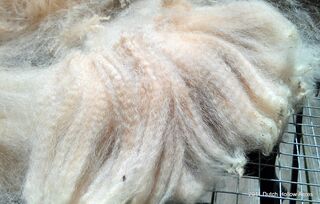
Raw Alpaca Fiber
What makes Alpaca fiber so amazing?
Alpaca fiber is hypoallergenic- it does not contain lanolin, an oil commonly found in sheep's wool which requires harsh chemicals detergents to wash out before processing. Alpaca fiber's microscopic scales are also shorter than wool of the same fineness, making it feel smoother on the skin.
Alpaca fiber is moisture wicking-it is water resistant and possesses moisture wicking properties. The fiber's semi-hollow core allows it to transfer moisture a read more...
|
Friday, January 21, 2022
1. It has been estimated that alpacas are 30% more efficient grazers than sheep.
2. Alpacas come in 22 colors ranging from white, fawn, brown, grey and black.
3. Alpacas can live for up to 20 years, The oldest alpaca on record lived to be 27 years old.
4. They produce a highly sought after "Fleece". They product 5-10lbs of this "Fiber" "Fleece" per annual shearing
a. Alpaca fleece (wool) is naturally water repellent, hypoallergenic and difficult to ignite.
b. I read more...
|
Friday, January 21, 2022
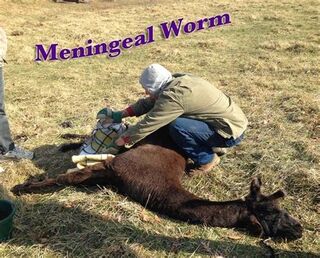
If not caught in time death is the end result
Meningeal Worm Introduction:
M-worm is a White Tailed Deer parasite that uses snails as it’s secondary host. Alpacas get infected when they eat those snails or even when they come into contact with the snail trails.
Meningeal Worm Prevention:
If you live in an area with White Tailed Deer (Please see provided reference map), You will want to put your Alpaca herd on a defined deworming schedule. Your local vet may also be able to help with a worming plan. I say "may" as it has been our expe read more...
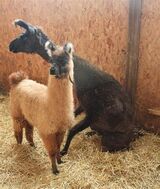
Early detection is Key
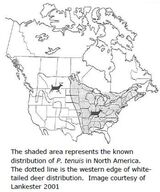
White Tail Deer Distribution Map
|